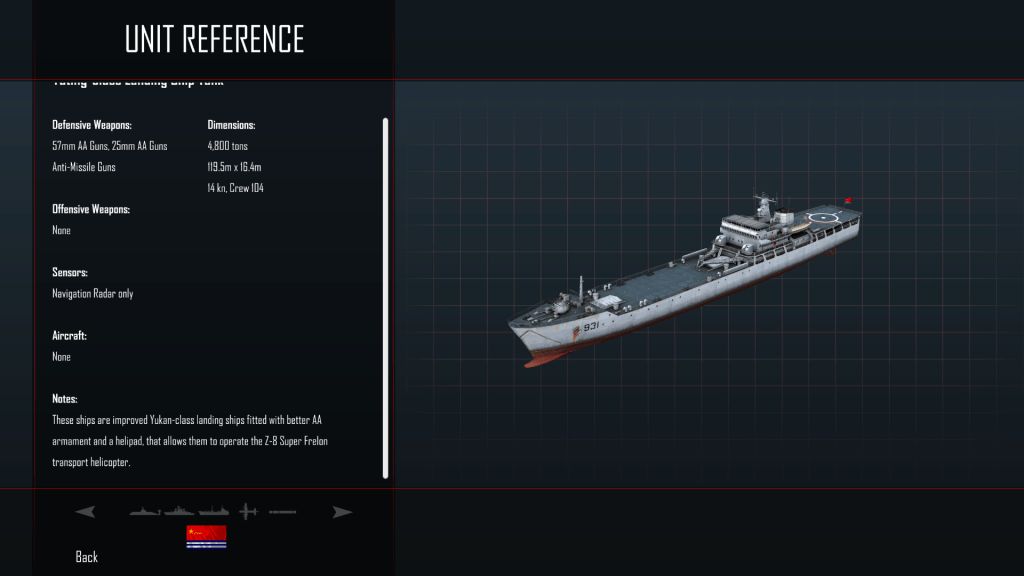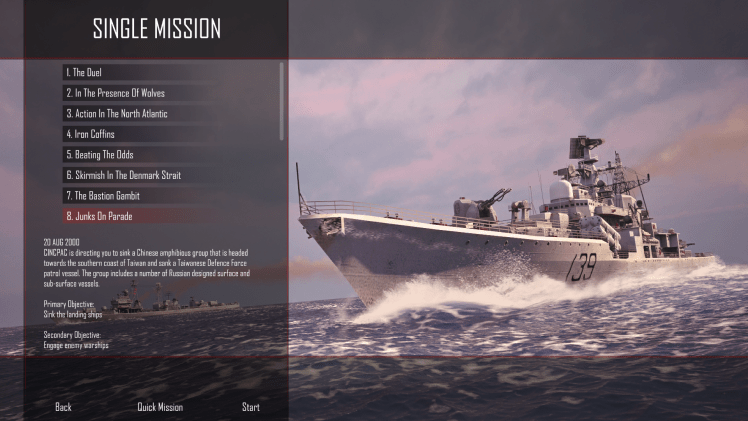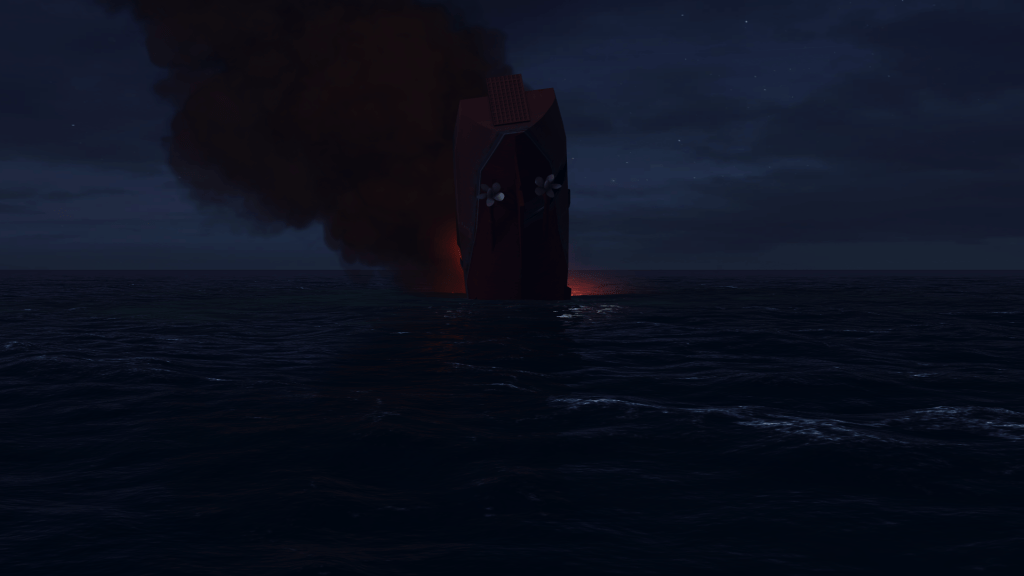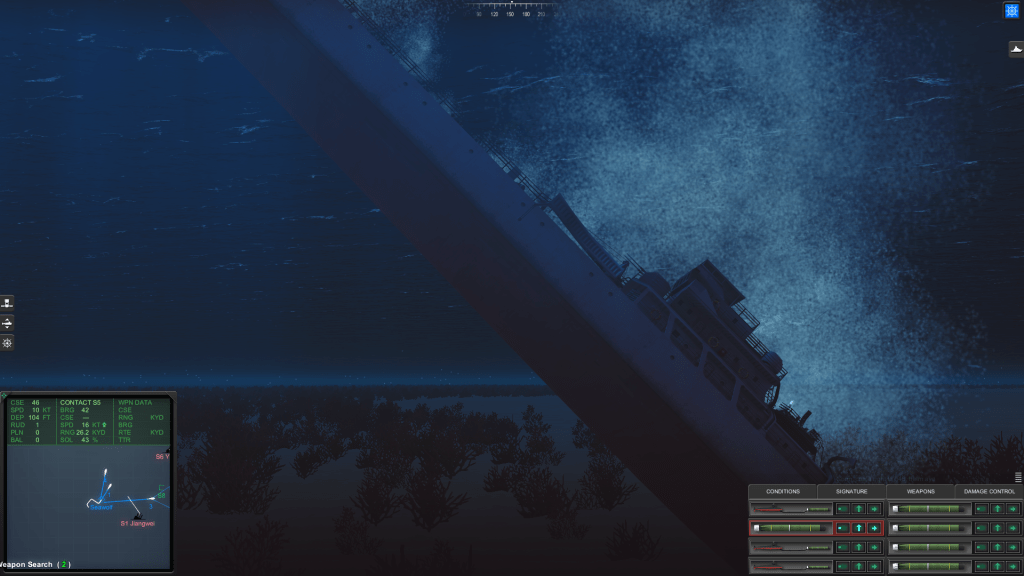
The date: 20 August 2000.
The time: 0700 Hours local time.
The situation: USS Seawolf (SSN-21) is in the shallow waters of the narrow Taiwan Straits under orders to intercept and destroy a Chinese amphibious group bound for Taiwan.
Primary Target: The merchant ships and landing craft of the People’s Liberation Army Navy’s invasion force.
Secondary Target: The escorting warships, which include a Sovremenny-class destroyer and several Jiangwei I class frigates.


This is the fourth time that I have played through the Junks on Parade scenario in Killerfish Games’ Cold Waters, and as always, it is quite a challenge. I have figured out how to successfully complete Junks on Parade without getting killed by either the surface escorts and/or the People’s Liberation Army Navy Aviation assets in the scenario, but today I had what I call “mixed results.”
On the plus side, today marks the first time that I have fought the Battle of the Taiwan Straits without once having to dodge any torpedoes or depth bombs. Don’t get me wrong: either a warship or an ASW aircraft (helo or fixed wing, I have no idea) fired a torpedo at my “boat” (Navy submariners never refer to subs as “ships”), but it was at a range far too distant for me to worry about; all it did was run in a relatively small circle until it ran out of fuel and self-destructed/hit the sea bottom.
I also managed to achieve the mission’s secondary objective, which was to engage and sink the enemy warships.

What makes Junks on Parade a challenge isn’t so much the number of escorts you have to deal with; the surface ships in this scenario can kill you, yes, but only if you make bonehead mistakes such as rising to periscope depth too soon, use your radar to acquire targeting data, and fire Harpoon or Tomahawk missiles at the escorts. The Chinese surface warships are armed with anti-sub weapons, and if they detect your boat too early in the engagement, they will counterattack and hunt you tenaciously, damaging or even destroying your boat while at the same time giving the PLAN merchant ships and amphibious vessels time to change course and get out of your weapons’ range.
No, Dear Reader, the factors that make this mission tricky are:
- Shallow Waters: The water depth in the section of the Taiwan Strait the game chooses as the battle site is extremely shallow. Modern nuclear attack subs are creatures of the deep, more at home in “blue waters” far from shore rather than shallow (150-250 ft.) coastal waters, so there’s no thermocline, no real maneuvering room in which to evade enemy torpedoes
- Aircraft: The Chinese are not stupid, not even if you set the game at Easy difficulty, and the AI has them behave as their real-life PLAN counterparts would in an actual China-U.S. naval war. So Junks on Parade features appearances by Shaanxi Y-8 ASW patrol planes and Harbin Z-9 helicopters. These aircraft try to detect you with magnetic anomaly detection (MAD) booms, sonobuoys, and dipping sonars. If they do, then they either drop ordnance on you or relay your estimated position to surface warships, and that can ruin your day

Today’s Battle of the Taiwan Straits was what I consider to be 90% successful. Using the lessons I learned in past sessions of Junks on Parade, I concentrated on eliminating the escorts first, even though doing so triggers a “let’s get out of here” maneuver on the part of the merchant ships and ‘phibs in the convoy.
Not only that, but the pesky Y-8 ASW plane flew overhead, dropping sonobuoys in an effort to hear the sound of my sub’s pump-jet propulsion or get a hit off the metal on my boat’s hull with his MAD boom.

The Y-8 (actually, the Y-8X variant) might have dropped a Yu-7 torpedo in an effort to flush my Seawolf-class boat (the most expensive sub ever built for the U.S. Navy…so pricey that only three were built) out from her nearly silent state by making me increase speed and thus reveal my position. But, as I said earlier, the drop point was too far ahead and off to one side, so all I had to do to evade the Yu-7 was steer carefully away from the torpedo’s “seeker cone” and creep away at five knots.
I made several successful torpedo attacks on enemy targets, even though this time around I broke my own rule of waiting until I have a good firing solution before launching torpedoes. I fired at least eight Mk. 48s at the convoy, sometimes without knowing if my target was a warship or a “merchie.”

But even though this was the first time in which USS Seawolf didn’t suffer any damage from Chinese weapons, and even though I sank the Sovremenny-class destroyer and all of the Jiangwei-class frigates, I only sank most of the ‘phibs and “merchies” that were my primary objective. According to my mission’s “after-action report,” I sank three landing ships and a merchant, but a Yuting-class landing ship, tank (LST) escaped, and another remained undetected.
Would that be considered a victory for the American Navy? Yes, assuming that the convoy commander or the senior officer present afloat (SOPA) in the surviving ‘phibs headed back to mainland China or that other U.S. and Taiwanese assets sank the remaining two vessels. In real life, no sane commander would press on into enemy waters without surface or sub escorts, and while this PLAN convoy had air support, it had no fighter aircraft to defend the helos and Y-8X from U.S. Air Force, U.S. Navy, or Taiwanese fighter planes.

One of the features that I miss from Red Storm Rising, the MicroProse game that inspired the design team at Australian game studio Killerfish Games to create Cold Waters is a mission Efficiency Report and some medal or commendation based on my command performance. I know the Campaign mode has this, but Red Storm Rising included medals and after-action reviews (and replays) in Single Mission mode, too.
Oh, well. It is what it is.


You must be logged in to post a comment.